All banks are encouraged to use the guidance documents for best-practice on key topics. Working groups of signatory banks worldwide have contributed to – or are actively engaged in – creating this guidance, working with experts in the field. Discover what leadership looks like by using the easy-to use guides below.
PRB Implementation for Banks

Principles for Responsible Banking Guidance
The Principles for Responsible Banking Guidance document is designed to support signatory banks' implementation of the Principles. It provides non-binding guidance to banks on measures they can take to implement each Principle. Each section of the Document begins with one ...
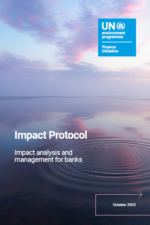
Impact Protocol
Impact management explained, step by step! The Impact Protocol provides a step-by-step overview of how to analyse and manage bank portfolio impacts as per UNEP FI’s holistic impact approach and in conformity with the requirements of the Principles for Responsible ...
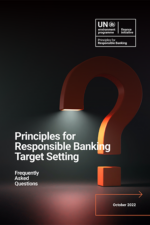
Principles for Responsible Banking Target Setting FAQ
Signatory banks of the Principles for Responsible Banking (PRB) align their business strategy and practice with the UN Sustainable Development Goals and the Paris Agreement by following three key steps: impact analysis, target setting and reporting. Once they finish analysing ...
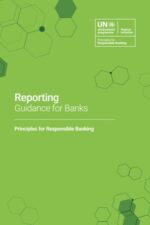
Guidance on Reporting and Providing Limited Assurance
How to Report Signatory Banks have committed to show their progress on implementing the Principles for Responsible Banking, and to be transparent about their impacts and contributions to society. As such, reporting on the implementation of the Principles is an ...
Guidance for Banks
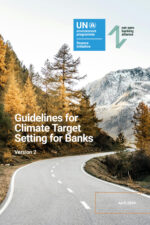
Guidelines for Climate Target Setting for Banks – Version 2
The Guidelines for Climate Target Setting for Banks outline key principles to underpin the setting of credible, robust, impactful and ambitious targets in line with achieving net zero by 2050 greenhouse gas emissions goals, including these four overarching principles: Banks ...
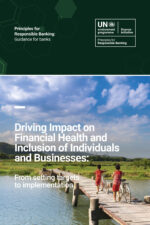
Driving Impact on Financial Health and Inclusion of Individuals and Businesses: From Setting Targets to Implementation
As economic, political, and environmental challenges strain families and businesses worldwide, the importance of financial health and inclusion has become increasingly evident for sustainable development. Financial institutions, as stewards of their customers' financial well-being, bear a crucial responsibility in promoting ...

Climate Adaptation Target Setting
The new Principles for Responsible Banking (PRB) Climate Adaptation Target Setting guidance aims to help banks accelerate their efforts on managing climate-related impacts and financing climate adaptation, by setting adaptation targets using the PRB impact framework. Building on a framing ...

PRB Nature Target Setting Guidance
Authored by the UNEP FI with the support of Principles for Responsible Banking (PRB) signatories, the new nature target-setting guidance aims to help the banking industry act on nature loss and set targets to align with the objectives of the ...
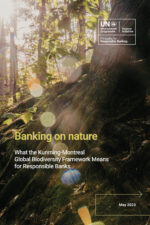
Banking on nature: What the Kunming-Montreal Global Biodiversity Framework means for responsible banks
As part of a series of publications to help financial institutions understand the relevance and implications of the Kunming-Montreal Global Biodiversity Framework (GBF), this briefing provides banks a first overview of how the GBF applies to their industry, through the ...
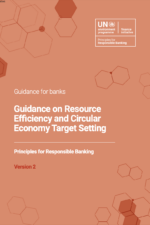
Guidance on Resource Efficiency and Circular Economy Target Setting – Version 2
Our current linear economic system is based on a take-make-waste model which relies on resource extraction and depletes natural capital. Such practices severely worsen the global challenges of climate change, biodiversity loss and pollution, and resource use is estimated to ...

Case studies on impact analysis and target setting
Signatory banks of the Principles of Responsible Banking are to set and publish targets in the areas where they have the most significant impacts on people and the environment. Both impact analysis and target setting are complex processes, requiring appropriate ...

Foundations of Climate Mitigation Target Setting
A getting-started guide on setting targets. Learn about the science, process, and context of target setting through this foundation guidance. As controllers and facilitators of capital, banks can be at the core of the systemic change needed to help decarbonise ...

Guidance on Gender Equality Target Setting
The Guidance on Gender Equality Target Setting delivers a practical example of what a gender equality target can look like, providing guidance on the different elements of setting targets in line with the requirements of the Principles for Responsible Banking, and ...


